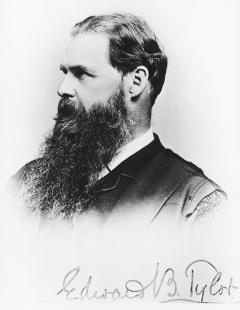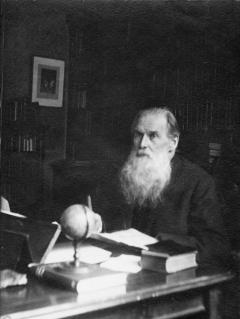ENGLAND: THE OTHER WITHIN
Analysing the English Collections at the Pitt Rivers Museum
Tylor and Technology
Alison Petch,
Researcher 'The Other Within' project
Edward Burnett Tylor (1832-1917) was the Keeper of the Oxford University Musuem (of Natural History) from 1882 and in 1895 was appointed the first Professor of anthropology at the University of Oxford. His connections with the Pitt Rivers Museum were strong but not direct. The Museum was considered part of the wider Oxford University Museum at the beginning but Henry Nottidge Moseley (and later, Henry Balfour) were charged with unpacking, arranging and curating the Pitt Rivers collection (and later the Museum). However, Tylor was certainly interested in many of the same issues as Augustus Henry Lane Fox Pitt Rivers and Henry Balfour and contributed both artefacts and ideas to the Museum. One of the points of linkage was Tasmanian stone tools, about which Tylor wrote in 1894. This was also a topic of discussion for Balfour, see here for more information. Tylor was certainly interested in different technologies, and was able to make fire using flints for example, as he demonstrated in several lectures.
This webpage discusses Tylor's 1894 paper.
It is hoped that Chris Wingfield will provide additional information about Tylor's interest in technology at a later date.
On the Tasmanians as representatives of palaeolithic man
This paper was read at the meeting of the Anthropological Institute on 21 March 1893 and published in 1894.
Tylor's interest in Tasmanian stone tools appears to have been piqued by an artefact in the Museum of the Somerset Archaeological Society at Taunton. He exhibited a cast of it at the meeting, 'formed from a flaked-off fragment, dressed by chipping ... and then finished by a series of blows ... leaving a cutting edge.' [Tylor, 1894: 141] This tool led him to question 'Dr Milligan, Commissioner for Tasmania' in 1862. In 1890, Tylor contributed a preface to 'Mr Roth's work' ['Aborigines of Tasmania' by H. Ling Roth] suggesting that the Tasmanians gave 'an idea of the conditions of the earliest prehistoric tribes of the Old World, at a somewhat less advanced stage of stone implement making than were the men of the Mammoth Period in Europe.' [Tylor, 1894: 143] Tylor was hampered, however, by the lack of Tasmanian stone tools in England.
At my request , it was brought under the notice of the Royal Society of Tasmania in 1890 ... I have also, through the help of Mr W.L. Williamson, of Brown's River, obtained a general collection of finished implements, wasters and chips much as they occur on the ground, in all about 150. These, with a small set of well-chosen examples in the hands of Mr H. Balfour, Curator of the Pitt Rivers Museum, give fair means of judging the general characteristics. [Tylor, 1894: 143]
Tylor proposed
By examination of the specimens exhibited ... state briefly the main points as to their material, make and use, with the view of using the position of the Tasmanians in the Stone Age as a standard for comparison with their position in general culture. [Tylor, 1894: 143]
Tylor's discussion of the techniques the Tasmanians employed to create their stone tools, uses ethnographic 'field-work' by people like James Scott and Brough Smyth to back up his observations.
There are statements of experienced observers that the implements were grasped in the hand for use, never mounted on handles. [Tylor, 1894: 145]
He then goes into the details of two witnesses' accounts. However, he also points out contradictory accounts from other witnesses. Tylor thought that a satisfactory explanation of this uncertainty was that 'the aborigines did not originally use these handles, but learned how to attach them from some New South Wales aborigines who came to this country in the early days of its settlement. [Tylor, 1894: 146]
Tylor felt that the the stone tools posed a problem:
The question which suggests itself on first inspection ... is how with such poor tools even the rude native crafts could be carried on.
His conclusion, however, was that
they are for practical purposes somewhat better than they look, being indeed made with great care and skill in getting the edges straight and the grip firm. [Tylor, 1894: 146]
He concluded from the evidence that 'the Tasmanians ... habitually used stone implements shaped and edged by chipping, not ground or polished. These belong ... to the order of the very ancient 'palaeolithic' implements of the Drift and Cave periods'. [Tylor, 1894: 147]
Rather than there having been a 'degeneration of culture' Tylor thought that
that in their remote corner of the globe they may have gone on little changed from early ages, so as to have remained to our day living representatives of the early Stone Age, left behind in industrial development even by the ancient tribes of the Somme and the Ouse.
Such being the position of the Tasmanians as modern tribes in the lowest Stone Age, the study of their culture in other respects affords valuable though imperfect guidance to formation of opinion as to the earliest distinctly recognizable period of human civilization. [Tylor, 1894: 148-9]
Tylor then discusses the Tasmanian material culture, religion, and social organization.
He concluded:
the effect of the present evidence may be stated as confirming and extending the argument, familiar on neolithic ground, that the condition of modern savages illustrates the condition of ancient stone age peoples, representatives of a stage of culture at once early in date and low in degree. The Tasmanian specimens and records now place us in full view of the state of a people in the palaeolithic stage, who may have lasted on their remote and unvisited home from the distant ages when rudely chipped stones grasped in the hand were still the best implements of mankind ... The life of these savages proves to be of undeveloped type alike in arts and institutions, so much so that the distinction of being the lowest of normal tribes may be claimed for them. [Tylor, 1894: 152]
Tasmanian tools donated by Tylor to the Pitt Rivers Museum
Tylor donated 1,510 stone tools from Tasmania to the Museum, most of these coming after his death, donated by his wife Anna. Many of the items he donated were collected by Joseph Paxton Moir. Others were collected by John V.Cook and Alexander Morton and W.L. Williamson.
Further Reading
Joan Leopold, Culture in Evolutionary and Comparative Perspective: E.B. Tylor and the Making of "Primitive Culture" (Berlin: Dietrich Reimer Verlag, 1980)
Marett, R.R. Modern Sociologists - Tylor. New York: John Wiley and Sons, Inc., 1936.
Myres, John Linton 1953. [no title] in 'Anthropology at Oxford: the proceedings of the five-hundredth meeting of the Oxford University Anthropological Society ... February 25th, 1953.
Stocking, G. 1987. Victorian Anthropology. New York: The Free Press.
Tylor, E.B. 'On the Tasmanians as representatives of palaeolithic man' The Journal of the Anthropological Institute of Great Britain and Ireland, Vol. 23 (1894), pp. 141-152

